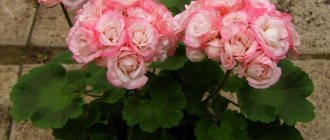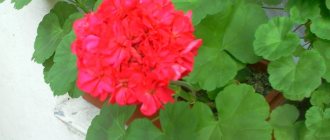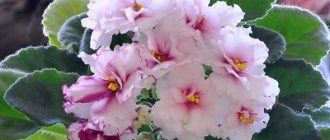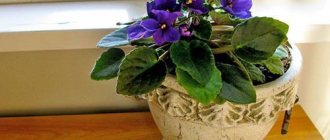Indoor violet is considered one of the most popular plants among gardeners. Delicate flowers leave no one indifferent, and a huge number of varieties and hybrids force Saintpaulia fans to purchase new specimens. The violet, the history of the origin of the flower and its structure deserve special attention. No less interesting are some historical facts about the plant, as well as signs and superstitions associated with it.
History of the origin of violets
Violet is an annual or perennial plant with dense double leaves and small inflorescences. Breeders have obtained a large number of varieties and hybrids that differ in bud color and size. However, the main advantage of the plant is its ability to flower. Violet blooms for a long period - up to 9 months, and the time of year does not affect this process.
Legends associated with violets
There are many legends and beliefs associated with Saintpaulia that explain its origin. Ancient Greek myths tell the story of the violet flower. Once Apollo incinerated a gentle nymph with his hot rays. The girl had to ask for protection from the powerful Zeus. He took pity and turned her into a beautiful violet, hiding her from the sun's rays in the thickets of the forest. He hid the beauty so that no one could see or admire her.
This continued until Persephone discovered the flower. She picked the bouquet. On the way back, Hades stole her. Persephone got scared and dropped the flowers. They woke up from Olympus to earth.
History of appearance in Russia
The history of the appearance of indoor violets in our country began with the appearance of the flower in Europe. In 1893 it was first introduced in Germany. In Russia, people learned about this unique flower in the middle of the 20th century. The largest collection of wild and selected specimens was collected by employees of Leningrad State University. Later, in 1962, the Makuni family began breeding and collecting violets. The couple has been breeding Saintpaulias for more than 30 years. During this period, they were able to breed over a hundred species.
Homeland of the flower
Saintpaulia's homeland is Africa, but it is difficult to name the exact place. It was first found in Tanzania. More often the flower can be found in Japan, the Andes, and northern America. Some species inhabit the subtropical regions of Brazil and South Africa. Saintpaulia also grows in New Zealand, in Europe, and in Russia it is found in the southern regions of Siberia. Any species in its natural habitat prefers open, slightly shaded areas of a temperate climate. For proper growth and development of the plant, a humid climate is required.
Biological classification
Species are combined into a separate genus. They belong to the herbaceous plants of the Gesneriaceae family. Based on the structure of the plant, violet is classified as follows:
- kingdom - plants;
- department – flowering;
- class – double-field;
- order – clear-flowered;
- family - Gesneriaceae;
- genus - Saintpaulia.
Other types of classification include characteristics based on the size of the rosette, the shape of the flower, the shades of the buds, the color and shape of the leaf blade.
How do plants reproduce?
Care and propagation vary depending on the specific variety. For the horned violet species, growing from seeds will be most relevant; the rest are best propagated using leaves and cuttings.
In the first case, you need to carefully examine the leaves. If you see thrips on violets, the leaves are definitely not suitable - look for exclusively healthy parts. Carefully cut the leaf and place it in a container with a nutrient substrate. Then place in a plastic bag and close tightly. An artificially created greenhouse effect will provide the plant with the required amount of moisture. Water the leaf from time to time, but do not allow it to become over-watered. As soon as new leaves begin to appear, the bag is removed. This will allow the plant to grow and develop independently.
And there is a second, simpler method of propagation by leaves. Find a good, healthy leaf, like in the photo, place it in a glass of water and wait for roots to form. As soon as they reach a length of 1 cm, the plant is planted in a pot.
You may have probably seen in photos or other articles that seeds are used to propagate flowers. It is worth noting that this method is quite complex, because the seeds need to be collected, the necessary conditions for growth must be created, planted and replanted correctly. Therefore, we recommend that you choose leaf propagation as a simpler and more affordable method.
Structure
Saintpaulia has a completely recognizable appearance. It cannot be confused with another indoor plant. The size is small, elastic leaves tightly cover the pot. The buds of the plant are small, growing above the leaf blade.
Saintpaulia has a tap root system. The roots are thin and easily damaged by careless manipulation. Flower growers should be aware that the root system of the plant develops quickly and deprives the soil of useful components. It is for this reason that Saintpaulia must be replanted annually. In addition to the root system, the parts of the violet plant include the stem, shoot, and flower.
Stem structure
The structure of the violet stem is unique. The plant is characterized by a low stem with a lush rosette of leaves in the root area. The leaf blades are rich green in color with abundant pubescence on the surface. They are quite wide and shaped like hearts. The edges of the leaf blade may be wavy. It is noteworthy that the shade of the leaf depends on gender. The structure of the violet leaf is characterized by the presence of short petioles and stipules.
Escape structure
The structure of the violet shoot does not have any special features. There are one to several flowers on the shoot. In addition to flowers, the peduncle has bracts. The process of reproduction directly depends on them. The more developed they are, the more suitable this peduncle is for reproduction.
Flower structure
The structure of a violet flower is classic: petals, pistil and stamens. In this case, the petals play a more decorative role. In natural wild conditions, they attract large numbers of insects for the pollination procedure. The pistil and stamens are involved in the fertilization process during breeding work. In turn, stamens have anthers and filaments.
Soil preparation for Saintpaulia and watering features
Perennial violet is planted in plastic pots with a diameter of 5 to 9 cm. Due to the root system of a superficial type, it is recommended to give preference to flat pots. Loose soil that absorbs water well and allows air to pass through is suitable. The store sells a ready-made base, although you can prepare it yourself. In order for the horned chrysalis violet and the Rococo variety to grow well, it must consist of 2 parts of humus and 2 parts of turf soil, 4 parts of half-rotten foliage, pine soil, sand and charcoal (1 part each). A bucket of this mixture is mixed with half a glass of ash and superphosphate (2 tablespoons).
Be sure to run hot water over the pot before filling it with soil. This will destroy harmful microbes.
In order for the night violet to bloom profusely, as in the photo, it needs to be periodically fed with fertilizers. You can mix them directly into the soil or dilute them with water for complex watering. In the second case, the concentration decreases by 6-7 times. This will prevent the plant from burning.
Also make sure that the vetch and garden violet are not covered with white dust. This deprives the flower of its aesthetics and prevents it from developing and breathing normally.
To prevent white dust from appearing, night violet and viola are watered with warm water twice a month. It is advisable to immediately cover the soil with paper or polyethylene. It is recommended to carry out water procedures in the evening or early in the morning. The plant will be able to dry out before the first rays of the sun touch it.
For watering, use tap water, previously brought to a boil and cooled.
Rules for constructing a story for younger children
To help a younger student write a story about Saintpaulia, you need to demonstrate the flower and provide details about it :
- The first thing you need to say is the name;
- Next, describe the bush, telling about the green fluffy leaves and bright flowers, which can be purple, blue, light blue, white, red;
- In a fascinating way, you can talk about the homeland of the culture and its preferences. Violets were born in Africa, so they love warmth, light and moisture;
- Among the care features are watering (every 2-3 days), light loosening of the soil, protection from cold and drafts. The flower propagates easily. One leaf with a cutting is separated from the rosette and placed in a separate glass with soil or water.
Advice! Concluding the story for the child, we can say that violet is a useful plant that purifies the air in the house.
Interesting Facts
Few people know that the popular flower has found its use in cooking. In addition, it has long been used in traditional and folk medicine.
Use in cooking
The low calorie content of dishes using the plant allows you to enjoy the unusual taste and will help you maintain your figure. Candied spiced flower petals, packed in boxes with the image of Empress Elisabeth of Bavaria, are a flower dessert that is a souvenir calling card of the capital of Austria - Vienna.
There are unusual dishes with flowers of a beautiful plant: pastries, drinks, desserts. The most common:
- violet cake;
- dessert “violet tenderness”;
- violet cocktail;
- Everyone's favorite treat is ice cream.
Application in medicine
Information about the medicinal properties of violets has been known since ancient times. Some parts of the plant are classified as medicinal, especially the roots and rhizomes, and have been used in medicine since ancient times. When included in the diet, violet gives a high healing effect, since it contains micro- and macroelements that are vital for the human body:
- manganese;
- glycosides;
- iron;
- calcium;
- magnesium;
- vegetable acids;
- saponin;
- inulin;
- violin.
The healing properties of the plant have been proven: antispasmodic, choleretic, antiseptic. In pharmaceuticals, violet is used as part of breast herbal teas to soften and thin the mucus in dry coughs and colds.
The aroma of flowers does not cause any allergic reactions. Perfumers widely use flower extracts to create perfumes and body oils. In addition to the wonderful aroma, such oils have a soothing effect on the skin and relieve irritation.
From the story about the violet for grade 2, children get acquainted not only with the botanical diversity and characteristics of plants, but also learn that they have not only decorative properties, but also medicinal and many others.
Basics of caring for homemade violets: what microclimate to create
Proper care requires some knowledge and skills, as well as a little experience, which is acquired over time.
Caring for violets does not require special knowledge
The right place for Saintpaulia: lighting and temperature
The violet feels comfortable on the windowsills of windows of eastern or western orientation. When placed near southern windows, the plant is shaded so that the sultry rays of the sun do not burn the delicate leaves. She needs good lighting .
- At midday in the warm season, you can disperse the rays using a mosquito net or curtain.
- Violets grow at home at a temperature of twenty-one to twenty-two degrees.
- During severe frosts in winter and hot days in summer, it usually does not bloom flowers.
Watering and humidity to grow
Violets are watered two to three times a week. The exact frequency of watering depends on humidity, time of year and soil. They are watered as the top layer of soil dries out. In summer it dries out faster, so the plant is watered more often. In winter, the frequency of watering is reduced : the soil is moistened only after the top layer of the substrate has completely dried.
Violet will tolerate a slight drought more easily than overwatering, so you should not overwater it. Usually, after a while, the gardener intuitively senses when the flower needs to be watered.
Water the violet without flooding the rosette of the flower
Water from above with a thin stream, aiming at the edge of the container to avoid moisture getting into the rosette and onto the young leaves. Water is poured until it comes out of the drainage holes. After twenty minutes, the water is drained from the pan.
The top layer of soil should not dry out completely .
Water the violet carefully, pouring water along the walls of the pot, without getting on the sockets. Water for irrigation is used settled, melted or filtered.
Flowers are also negatively affected by dry indoor air due to central heating. In this case, the necessary air humidity is created.
Feeding a houseplant
Violets are fed with complex fertilizers, which are sold in specialized stores. Fertilizers include nitrogen, phosphorus and potassium. Nitrogen helps leaves actively develop, phosphorus helps them bloom. Leaves need potassium for elasticity . It also speeds up the appearance of flowers.
Transplantation, choice of soil and pot
It is not recommended to use old containers for planting that have salt deposits on them. When replanting, take a pot larger than the previous one. It is recommended to use plastic pots. The soil should contain peat and sand.
Good drainage consisting of expanded clay or sphagnum moss is placed at the bottom of the pot. Then the plant is replanted with partial or complete replacement of the soil or by transshipment.
| Step 1 | Completely change the soil if the soil is sour |
| Step 2 | They also get rid of the old substrate if adult plants wither and lose leaves. Then it is possible to clean the roots from the ground, inspect them and remove damaged parts |
| Step 3 | Part of the soil is changed if young plants or mini-violets are replanted |
The transshipment method is used if a blooming violet , baby or flower with a large rosette is transplanted. Then the lump of earth is removed from the pot and placed in a new one. The space on the sides is filled with earth.
When transshipment, the plant is replanted together with an old clod of earth.
The beautiful violet has come a long way from its natural habitat to home conditions. It attracted the discoverer's attention with its bright colors with a contrasting center. This same beauty also attracts flower growers around the world, who turn violet breeding into their life’s hobby.
Children's stories
"Violet at the North Pole"
Among the stories about this flower, the work “Violet at the North Pole” (by Gianni Rodari) . It tells the story of Saintpaulia, which blossomed among the ice. She was noticed by polar bears and other animals. They began to discuss a previously unprecedented phenomenon, admired the beauty of the plant and enjoyed the pleasant aroma.
Violet tried her best to melt the snow and turn the area into a warm clearing. At night, when the animals fell asleep, the ice crackled and began to break under the influence of the wonderful aroma that the plant exuded. But the strength of the green bush quickly dried up, and by morning it withered.
Illustration for the fairy tale “Violet at the North Pole.”
Attention! At the end of the story, the violet pronounces words that are the moral of the work. She says that the main thing is to start acting and after some time your plans will come true.
"Young Wind"
Another story by an unknown author about this plant is called “Young Wind” . It talks about a young wind that witnessed the tender friendship of a boy and a girl.
Every day the children walked together and collected violets, and then wove wreaths. After some time, the boy had to leave, but such plants did not grow in his country.
Then the young wind asked his brothers to help and they lifted a huge number of violets into the air and carried them all over the world , including to where the boy lived.
As a result, despite the fact that friends lived in different countries, both the girl and the boy remembered each other all their lives thanks to the violets that grew next to them.
Fairy tale "Violet and Snowdrop"
An unusually touching tale about a violet about friendship and love (author M.A. Andrianov). The plot develops in a small clearing where a snowdrop and a beautiful violet have grown. They became friends.
One morning the violet noticed a caterpillar crawling towards a snowdrop to feast on its leaves. The brave beauty blocked the path and gave her petals and leaves to be eaten.
A little later, the snowdrop woke up and did not recognize her friend, who had lost some of her foliage and petals. Snowdrop decided not to communicate with such an ugly creature anymore.
Violet did not tell him what happened to her, but simply began to hide from her friend so as not to frighten him with her appearance. After a long time, the snowdrop saw a beautiful butterfly flying over the clearing. She sank down to him and began to ask if he had seen the damaged violet, which, defending its friend, gave itself up to be torn to pieces.
A clearing with violets, snowdrops and other primroses.
The snowdrop realized what had happened and began to call the violet. But the friend did not show up, then the butterfly itself flew to the place where the snowdrop was pointing. There lay a dried Saintpaulia. Snowdrop was very upset and cried for a long time.
But one day a butterfly with purple wings flew to him. She said that she used to be his friend violet and still loves him and is not offended by him . They became friends again.
Life cycles
When buying a little baby, you always wonder how long such flowers grow. Violets grow quite quickly, from a small baby to an adult blooming violet in just six months to a year, depending on the variety.
It takes no more than a year from cutting to adult plant.
Violets are propagated by leaves, shoots and peduncles. Children from stepchildren bloom the fastest, and later than all from peduncles.
The stages of violet growth can be divided:
- A cutting from a leaf or peduncle (leaves are taken from the second or third row and rooted in a convenient way);
- A baby from a cutting or a stepson (children are separated from the cuttings when they reach a height that allows them to exist independently; stepchildren are separated from the mother at approximately the same size, preferably with several roots);
- Starter or teenager (a violet that is ready to bloom, and often is already blooming, but has not yet reached its adult height);
- Adult.
We suggest you familiarize yourself with What herbs help against hair loss
Shoots or stepsons are formed in the axils of the leaves. They grow quite quickly and when they reach the size of a large baby, they are removed.
Important! Knowing how violets grow in nature, they
cultivation
at home will not cause much difficulty.











